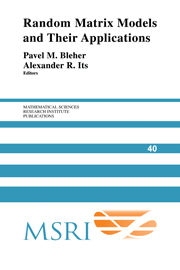Book contents
- Frontmatter
- Contents
- Preface
- Symmetrized Random Permutations
- Hankel Determinants as Fredholm Determinants
- Universality and Scaling of Zeros on Symplectic Manifolds
- z-Measures on Partitions, Robinson-Schensted-Knuth Correspondence, and β = 2 Random Matrix Ensembles
- Phase Transitions and Random Matrices
- Matrix Model Combinatorics: Applications to Folding and Coloring
- Interrelationships Between Orthogonal, Unitary and Symplectic Matrix Ensembles
- Dual Isomonodromic Tau Functions and Determinants of Integrable Fredholm Operators
- Functional Equations and Electrostatic Models for Orthogonal Polynomials
- Random Words, Toeplitz Determinants, and Integrable Systems I
- Random Permutations and the Discrete Bessel Kernel
- Solvable Matrix Models
- The τ-Function for Analytic Curves
- Integration over Angular Variables for Two Coupled Matrices
- Integrable Lattices: Random Matrices and Random Permutations
- SL(2) and z-Measures
- Some Matrix Integrals Related to Knots and Links
Solvable Matrix Models
Published online by Cambridge University Press: 25 June 2025
- Frontmatter
- Contents
- Preface
- Symmetrized Random Permutations
- Hankel Determinants as Fredholm Determinants
- Universality and Scaling of Zeros on Symplectic Manifolds
- z-Measures on Partitions, Robinson-Schensted-Knuth Correspondence, and β = 2 Random Matrix Ensembles
- Phase Transitions and Random Matrices
- Matrix Model Combinatorics: Applications to Folding and Coloring
- Interrelationships Between Orthogonal, Unitary and Symplectic Matrix Ensembles
- Dual Isomonodromic Tau Functions and Determinants of Integrable Fredholm Operators
- Functional Equations and Electrostatic Models for Orthogonal Polynomials
- Random Words, Toeplitz Determinants, and Integrable Systems I
- Random Permutations and the Discrete Bessel Kernel
- Solvable Matrix Models
- The τ-Function for Analytic Curves
- Integration over Angular Variables for Two Coupled Matrices
- Integrable Lattices: Random Matrices and Random Permutations
- SL(2) and z-Measures
- Some Matrix Integrals Related to Knots and Links
Summary
We review some old and new methods of reduction of the number of degrees of freedom from ∼ N2 to ∼N in the multimatrix integrals.
1. Introduction Multimatrix integrals of various types appear in many mathematical and physical applications, such as combinatorics of graphs, topology, integrable systems, string theory, theory of mesoscopic systems or statistical mechanics on random surfaces.
We will consider here only the case of hermitian matrices for which Q belongs to the U(N)-group.
In many applications “to solve” the corresponding matrix model usually means to reduce the number of variables by explicit integrations over most of the variables in such a way that instead of QN2 original integrations (matrix elements) one would be left in the large N limit only with ∼ N integration variables. In this case the integration over the rest of the variables can be performed, at least in the widely used large N limit, by means of the saddle point approximation. A more sophisticated double scaling limit [1] is also possible (if possible at all) only after such a reduction. The key of success is in the fact that after reduction the effective action at the saddle point is still of the order ∼ N2 whereas the corrections given by the logarithm of determinant of the second variation of the action cannot be bigger than ∼ N (the “entropy” of the remaining variables). The problem is thus reduced to the solution of the “classical” saddle point equations, instead of the “quantum” problem of functional (in the large N limit) integration over the original matrix variables.
Information
- Type
- Chapter
- Information
- Random Matrix Models and their Applications , pp. 271 - 284Publisher: Cambridge University PressPrint publication year: 2001
